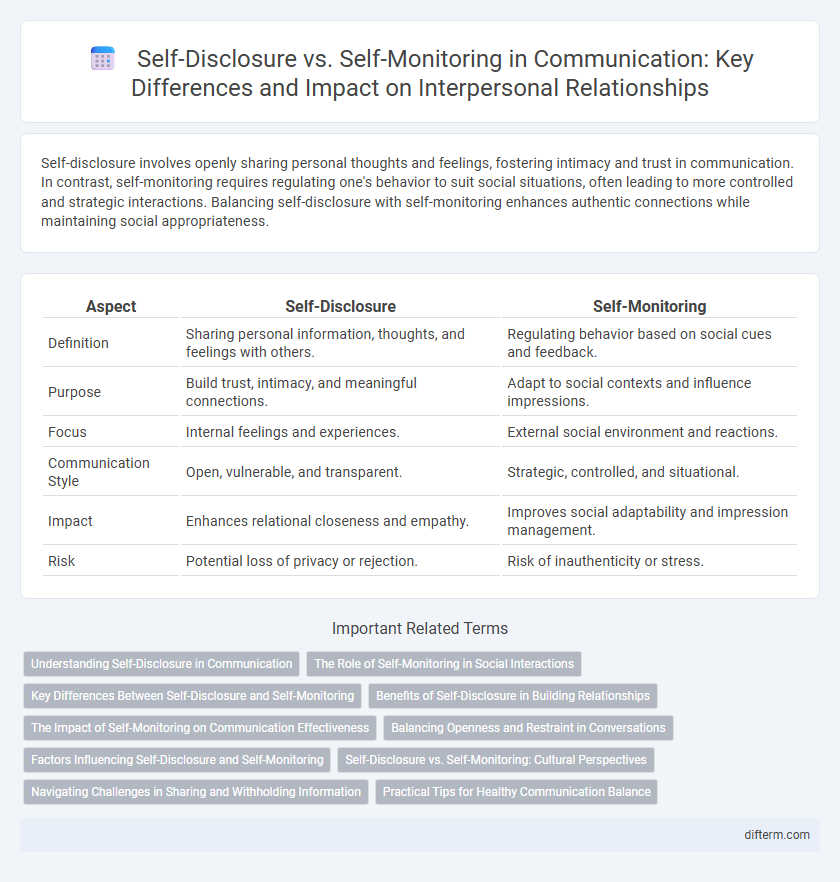Self-disclosure involves openly sharing personal thoughts and feelings, fostering intimacy and trust in communication. In contrast, self-monitoring requires regulating one's behavior to suit social situations, often leading to more controlled and strategic interactions. Balancing self-disclosure with self-monitoring enhances authentic connections while maintaining social appropriateness.
Table of Comparison
| Aspect | Self-Disclosure | Self-Monitoring |
|---|---|---|
| Definition | Sharing personal information, thoughts, and feelings with others. | Regulating behavior based on social cues and feedback. |
| Purpose | Build trust, intimacy, and meaningful connections. | Adapt to social contexts and influence impressions. |
| Focus | Internal feelings and experiences. | External social environment and reactions. |
| Communication Style | Open, vulnerable, and transparent. | Strategic, controlled, and situational. |
| Impact | Enhances relational closeness and empathy. | Improves social adaptability and impression management. |
| Risk | Potential loss of privacy or rejection. | Risk of inauthenticity or stress. |
Understanding Self-Disclosure in Communication
Self-disclosure involves revealing personal information, thoughts, and feelings to others, which fosters trust and deepens interpersonal relationships. In contrast, self-monitoring is the process of regulating and adjusting one's behavior to fit social situations, often limiting the extent of self-disclosure. Understanding the balance between self-disclosure and self-monitoring is crucial for effective communication, as it influences relationship development and social perceptions.
The Role of Self-Monitoring in Social Interactions
Self-monitoring plays a crucial role in social interactions by enabling individuals to adjust their behavior and communication style based on social cues and situational demands. High self-monitors are adept at reading social contexts and modifying their self-disclosure to maintain desired impressions, leading to more effective and adaptive interpersonal connections. This ability to regulate self-presentation enhances relationship building and facilitates smoother social exchanges compared to low self-monitors who disclose more consistently regardless of context.
Key Differences Between Self-Disclosure and Self-Monitoring
Self-disclosure involves revealing personal information, thoughts, and feelings to others, fostering intimacy and trust in communication. Self-monitoring is the process of regulating and adjusting one's behavior in social situations to create a desired impression. The key difference lies in self-disclosure being about openness and authenticity, while self-monitoring emphasizes strategic control and adaptability in social interactions.
Benefits of Self-Disclosure in Building Relationships
Self-disclosure fosters trust and intimacy by allowing individuals to share personal experiences, feelings, and thoughts openly, which deepens emotional connections. It encourages mutual understanding, promotes empathy, and reduces uncertainty in relationships, enhancing relational satisfaction. Sharing authentic information creates a foundation for stronger, more meaningful interpersonal bonds that contribute to long-term relationship stability.
The Impact of Self-Monitoring on Communication Effectiveness
High self-monitoring enhances communication effectiveness by enabling individuals to adapt their messages based on social cues and audience feedback. This skill improves interpersonal interactions, fostering clarity and reducing misunderstandings in diverse contexts. Research shows that people with developed self-monitoring capabilities achieve better conflict resolution and rapport-building outcomes.
Balancing Openness and Restraint in Conversations
Balancing openness and restraint in conversations requires understanding the dynamics between self-disclosure and self-monitoring. Self-disclosure involves sharing personal thoughts and feelings to build trust, while self-monitoring helps regulate what and how much is shared to maintain appropriateness and protect privacy. Effective communicators adjust their level of openness based on social cues and context, promoting meaningful yet respectful interactions.
Factors Influencing Self-Disclosure and Self-Monitoring
Factors influencing self-disclosure include trust, perceived risks, and the anticipated benefits of sharing personal information, which affect the depth and breadth of communication. Self-monitoring is shaped by situational cues, social expectations, and individual differences in awareness and adaptability, determining how people regulate their expressive behavior. Both processes are interrelated, as higher self-monitoring often leads to more strategic self-disclosure in varying social contexts.
Self-Disclosure vs. Self-Monitoring: Cultural Perspectives
Self-disclosure varies significantly across cultures, with individualistic societies encouraging open sharing of personal thoughts and feelings, while collectivist cultures emphasize restraint to maintain group harmony. Self-monitoring is culturally influenced as well, often higher in collectivist environments where individuals adjust their behavior to align with social norms and expectations. Understanding these cultural differences enhances effective communication by acknowledging how self-disclosure and self-monitoring shape interpersonal interactions globally.
Navigating Challenges in Sharing and Withholding Information
Self-disclosure involves revealing personal thoughts and feelings, fostering trust and intimacy, while self-monitoring requires regulating expressions to align with social norms or situational demands. Navigating challenges in sharing and withholding information balances authenticity with strategic communication, where excessive disclosure can risk vulnerability and overly rigid self-monitoring may hinder genuine connection. Effective communicators assess context, audience, and potential impacts to optimize transparency without compromising relational dynamics.
Practical Tips for Healthy Communication Balance
Balancing self-disclosure and self-monitoring fosters healthy communication by promoting authenticity while maintaining appropriate boundaries. Practicing selective sharing based on audience and context ensures openness without oversharing, enhancing trust and respect. Regularly reflecting on emotional responses and adjusting communication cues can prevent misunderstandings and support relational harmony.
self-disclosure vs self-monitoring Infographic

 difterm.com
difterm.com